- Home
- Edgar Allan Poe
The Slender Poe Anthology
The Slender Poe Anthology Read online
Library of Congress
Copyright © 2013
Sacramento Public Library
All rights reserved.
This book may not be reproduced, in whole or in part, in any form (except by reviewers for the public press), without written permission from Sacramento Public Library.
Library of Congress Cataloging-in-Publication Data
Poe, Edgar Allan, 1809–1849
Slender Poe Anthology, The / Edgar Allan Poe ;
introduction and commentary by John Allen Cann ;
foreword by Rivkah Sass.
xii, 251 pages, 23 cm.
ISBN 13: 978-0-9889839-6-0 (paperback)
1. Fiction – Horror Tales – 19th Century. 2. Poetry, Modern – 19th Century. 3. Literature, Modern – 19th Century.
4. Anthologies – American Literature – 19th Century.
I. Poe, Edgar Allan. II. The Slender Poe Anthology.
III. Cann, John Allen.
Library of Congress Control Number: 2013914008
Cover design and book layout by Laura Koivunen for Sacramento Public Library. The text of this book is set in ITC New Baskerville and Calendas Plus. Printed on the Sacramento Public Library’s I Street Press Espresso Book Machine.
Printed in the United States of America.
CONTENTS
Foreword
Introduction
Eleonora
To Helen
Eldorado
Shadow — A Parable
To One in Paradise
Hop-Frog
The Masque of the Red Death
The City in the Sea
The Power of Words
Silence — A Fable
Alone
Letter to Mr. B———, 1831
Sonnet — to Science
The Domain of Arnheim
The Oval Portrait
The Colloquy of Monos and Una
The Conqueror Worm
The Conversation of Eiros and Charmion
Israfel
To ———
Lines from the Critical Prose
The Raven
Regarding C. Auguste Dupin
The Purloined Letter
The Haunted Palace
The Imp of the Perverse
The Bells
Annabel Lee
The Premature Burial
FOREWORD
Rivkah K. Sass, Library Director
Welcome to our annual One Book Sacramento celebration in which everyone in our community reads, discusses and celebrates the same book. Our selection this year is a special one. Thanks to a member of our creative community, John Allen Cann, professor of literature and English composition at Cosumnes River College, our extraordinary graphic designer, Laura Koivunen, and the wild idea, “What if we…,” we are so pleased to present The Slender Poe, our own anthology of Edgar Allan Poe.
As far as we know, The Slender Poe is unique. Of the libraries around the world that have sponsored “one book, one community” events since Nancy Pearl conceived the idea in Seattle in 1998, we believe that Sacramento is the first to curate and publish its own collection.
Edgar Allan Poe is uniquely American. His incredible creativity, his tragic life and his mysterious death add to the mythology of Poe. He is credited with writing the first detective story and for inspiring Arthur Conan Doyle. All the women in his life died tragically. He might have been an alcoholic. In other words, if Edgar Allan Poe were around today, he would be a rock star.
We are grateful to the Friends of the Pocket-Greenhaven Library, an affiliate of the Friends of Sacramento Public Library, for their generous support in producing The Slender Poe. They believed in our idea and helped us make it so!
We offer this collection with the hope that you will discover or rediscover Edgar A. Poe, read some old favorites, discover some new works and celebrate your freedom to read.
Thank you.
INTRODUCTION
John Allen Cann
I don’t know if Wallace Stevens had Edgar Allan Poe in mind when he penned, “Authors are actors, books are theaters,” but he might as well have. For Poe, there is a keen theatric dimension to his tales and poems; every page is a stage. His work calls out to be read aloud, to be given voice. It’s the best way to savor his words. And his words have proven to be among the most influential ever written by an American.
Let’s begin with Seven Keys to his life:
Key No. 1 – All the Men and Women Merely Players.
Poe’s parents were both thespians. His mother, English-born Elizabeth Arnold Poe, had been working American stages since she was 9, developing into a very popular actress, noted for her attractive looks, sweet voice and comedic skills. Eliza took her turn with major Shakespearean roles, too, playing Ophelia and Juliet before New England audiences. Her second husband, David Poe, Jr., was not her equal on the boards; by all accounts, his good looks were in advance of his histrionic skills. He possessed a quick temper and a proclivity for excessive drink. Edgar was born January 19, 1809, while the pair were playing Boston. By July of the following year, David Poe had disappeared, leaving his pregnant and consumptive wife with their two small boys.
Key No. 2 – Groomed For a Life He Could Never Afford.
At age 24, Eliza Poe died in Richmond, Virginia, on December 8, 1811, with Edgar likely present at her death. The next morning, Francis Allan, one of the “kind hearted of the city” who had taken a charitable interest in the dying actress and her children, came for Edgar. After some initial resistance, “Fanny” persuaded her Scottish-born husband, John, to bring Edgar into their childless home. Though never formally adopted, he was reared as their son with all the expectations of his becoming a Southern gentleman. His youth included a five-year stint in Britain, mostly in London, where John Allan brought his family while endeavoring to expand his mercantile business. His venture failed and his debts were considerable by the time he returned with his family to Richmond in 1820. Already tense, Edgar and Allan’s relationship became more volatile in the following years.
Key No. 3 – Athlete, Scholar, Soldier.
Never more than 5’ 8” and slight of build, nevertheless, in his youth Poe was athletic: a boxer, swimmer and gymnast. He had the gift for leadership among his childhood friends. His skill with languages was in evidence early, as was his interest in writing poetry. At 17, he entered the University of Virginia, where he distinguished himself academically but, in an effort to compensate for a shortage of funds, he took up gambling with classmates and incurred considerable debts. His lifelong problem with drinking began in earnest here. He didn’t return for a second year; John Allan saw no reason to honor his ward’s debts; fractious rows ensued. The grievances Poe and Allan had with each other climaxed with Edgar’s angry departure early in 1827 from Moldavia, the mansion Allan had built after inheriting a fortune from a wealthy uncle. By May, Poe had enlisted in the U. S. Army as “Edgar A. Perry.” The military life gave him structure and focus; he was rapidly promoted to the rank of sergeant major. His eyes turned toward West Point and the career of a commissioned officer. Fanny Allan died just after Poe turned 20; he wasn’t called home for a final farewell. With John Allan’s help, he entered the academy in May of 1830; however, his fortunes took a hard downturn when Allan remarried later that year in October, severing all ties with Poe.
Key No. 4 – Pale and Spectre Thin.
Consumption, or tuberculosis, was the all-too real bugaboo of Poe’s life. The three most significant women in his life—his mother, Eliza, his foster mo
ther, Fanny, and his wife, Virginia— each slowly faded into death through its agency. As scholars have since noted, at the time the disease was thought romantic and even fashionable.
Key No. 5 – Magazinist.
Disenchanted with the prospects of a military life, Poe engineered a friendly court-martial. On his own, he began writing for and working in the fast-growing American industry of magazines and journals and would do so the rest of his life. His first tales appeared in the Saturday Courier of Philadelphia during 1832, anonymously. Three years later, he was back in Richmond, working for the Southern Literary Messenger, where he began to develop a national reputation as editor, critic and fiction writer.
Key No. 6 – Til Death Do Us Part.
In May 1836, Poe married his cousin, Virginia Clemm, who was almost 14 years old. The newlyweds’ household was managed by Maria Clemm, her mother. This was to be the nuclear trio of Poe’s most secure domestic circumstances. Virginia and her mother adored Poe. Virginia, pretty, plump, and possessed of gentle manners, a lovely voice, and a child-like simplicity, was the love of Poe’s life. In 1842, while singing at their piano, she began to bleed from her mouth; for the next fortnight, she was perilously ill, close to death. She recovered, but never fully; consumption made its claim. The fluctuations of her health were an emotional rollercoaster Poe would ride until her death in 1847, eleven days after his 38th birthday. After her passing, Poe was never quite the same.
Key No. 7 – Lost Days of the Final Trip.
Poe sank into depression and drink for the rest of 1847, a hard year: Muddy Clemm and Marie Louis Shew nursed him back from the abyss. The following year, his health and productivity improved, though he began a series of somewhat frenzied romances, proposing to several of the women. He was lecturing and trying to raise money for his own journal, The Stylus. In early summer 1849, Poe arrived in Philadelphia during a cholera epidemic; hallucinations beset him from a mix of medication, alcohol, and extreme anxiety; he ended up having to be ministered back to health by friends. One of them paid for his train trip to Richmond, where he was reunited with his boyhood sweetheart, the widowed Elmira Royster Shelton, to whom he became engaged. A few days after he delivered his lecture, The Poetic Principle, to an admiring and appreciative audience, he boarded a ship for Baltimore. A week after his arrival, a week whose events will remain forever unknown, he was found ‘the worse for wear’ in clothes not his own, outside a polling booth, delirious. Four days later—while under hospital care—on October 7, 1849, he died from what was termed “congestion of the brain.”
In the days approaching his untimely death, Poe wrote, “I do believe God gave me a spark of genius, but he quenched it in misery.” Fate was unkind to Poe; misfortune badgered him all his life. Yet, would he otherwise have created such a wildly singular and enduring body of work? In his creativity and his visions, I like to think Poe had his bliss, that he gave truth to the words of Kahlil Gibran’s The Prophet, “The deeper sorrow carves into your being, the more joy you can contain.”
In his brief essay, “The Poet,” Carl Jung writes, “Creativeness, like the freedom of the will, contains a secret.” It’s simply quite staggering how much has been written about Poe, yet some secret remains inviolate regarding just how this man came up with the work he did.
I like to think of Poe as our folklorist; his tales are Grimm to us. He shaped his wild and unruly reveries into tales cunningly contrived to keep himself cool. Truly there was “method in his madness”—and we are made his confederates by the uncanny craft of his story-making.
A very good thing to remember about Poe is his industry; this man wrote a great deal in the roughly twenty years of his professional career. Not only those tales and poems that are irreplaceable, but much that would fill copy for an approaching deadline. In his review work, he essentially initiated serious criticism in our country. Doing so, he became known as “the tomahawk man,” and caused resentment in quarters where later he could have used allies. Perhaps these words from Edmund Wilson’s “Poe as a Literary Critic” might provide some perspective: “The truth was that literary America has always resented in Poe the very superiority which made him so quickly an international figure.”
There will always be those who consider Poe a deathmonger. But in the early decades of 19th century America, death was a more intimate affair than it is today. It more often than not took place at home, and it was more common at an early age. There is no question that Death, The Mighty X, is central to his work; one could almost go so far as to rephrase the medieval maxim as a governing principle of his oeuvre: Death’s center is everywhere and its circumference nowhere. But then let us briefly consider how death filters into the work of the two greatest American poets of the 19th century, Emily Dickinson and Walt Whitman.
In the New England of Dickinson’s day, the Angel of Death could be seen grinning from gravestones that greeted a town’s visitors as they toured the local cemetery, much as we nowadays tour a museum. Always an eager, perceptive reader, Emily was given a volume of Poe in 1854 by a possible suitor who was leaving Amherst. She was not yet 24, and had composed only five of the poems that thirty-two years later, after Emily’s burial, her sister would discover in a locked box in the poet’s bedroom. Out of the 1,775 poems she left behind, we know now that a hefty portion deal in some way with death. A trio of her most anthologized pieces open like this: “Because I could not stop for Death—/ He kindly stopped for me—”; “I felt a funeral in my brain,”; “I died for Beauty—but was scarce/ Adjusted in the Tomb…”
While Whitman walked the hospitals in Washington during the Civil War, nursing the wounded, he saw plenty of death, plenty of young men from both armies about to die. Poe had published a couple of his articles during 1845, when he was editor of the Broadway Journal. Their paths crossed; later Whitman wrote, “I have a distinct and pleasing remembrance of his looks, voice, manner, and matter; very kindly and human, but subdued…” Two decades after their meeting in the offices of the Broadway Journal in 1865, Whitman composed his elegy for Lincoln, When Lilacs Last in the Dooryard Bloom’d, wherein the poet flees “down to the shores of the water” to hear the gray-brown thrush sing:
Come lovely and soothing death,
Undulate round the world, serenely, arriving, arriving,
In the day, in the night, to all, to each,
Sooner or later delicate death.
Sleep is the image of death, and in sleep, we dream. In one of Poe’s earliest poems, he exclaims at the outset, “Oh! that my young life were a lasting dream!” And around the same time, his 18th year or so, he began a poem that in its final form would pose this question: “Is all that we see or seem/ But a dream within a dream?” Poe’s work is tinctured with dream.
In one of the most interesting of his Marginalia, from the March 1846 issue of Graham’s Magazine, Poe speaks of “shadows of shadows”—fancies he calls them for want of a better name—which arise “where the confines of the waking world blend with those of the world of dreams” and which are so novel, they are beyond “the power of words” to describe, though he does say of these “psychal impressions”: “It is as if the five senses were supplanted by five myriad others alien to mortality.” They come only at moments of intense tranquility and sound health, therefore are inherently rare, but when circumstances are favorable, Poe feels “the capacity of inducing or compelling” this “instantaneous intuition” of “the spirit’s outer world.” Many of his poems and tales enact this movement to the “the very brink of sleep”; the apotheosis is a kind of visionary swoon suggested by lines composed around a year later:
This standing motionless upon the golden
Threshold of the wide-open gate of dreams
Gazing, entranced. . .
Not long ago I dreamt of Ralph Waldo Emerson and Poe riding together in the car of a speeding train, perhaps on route to where each was lecturing. At first they were merely cordial to one ano
ther, but soon warmed while discussing the loss of their beloved young wives to consumption. They drew closer; the conversation became lively as they spoke of the supernal solace of nature, how poetry has never been defined to the satisfaction of all parties, and the transcendent power of Shakespeare. Poe said something to the effect that beauty is how the divine speaks to us, and Emerson replied, “Though we travel the world over to find the beautiful, we must carry it with us, or we find it not.” Unaccountably, I was compelled to get off at the next stop; I watched with melancholy wonder as the pair in their train car sped far beyond the horizon.
Poe is all about what he calls Taste—it’s the poetic intellect. He places its operation between the faculty of mind that deals with Truth and the one that serves Duty—Taste desires Beauty. It’s an aesthetic consciousness—and beauty affords us something of a spiritual experience. But by its own nature, beauty is ephemeral—the gorgeous sunset blending raspberry and tangerine in the molten clouds above a cobalt blue sea will not stay—it will pass. As Stevens unforgettably puts it, “Death is the mother of beauty.” And yet, part of us feels e. e. cummings is right too, when he says: “beauty is more now than dying’s when.”
Charles Baudelaire, thought to be by many the greatest French poet of the 19th century, recognized in Poe a mind already at home in Paris, though Poe had never left the precincts of America. I think it might be wise to enlarge the circle of contemporaries with which Poe is usually associated. During his lifetime there was a remarkable vibe resonant across Europe. We may imagine Poe, even on the other side of the Atlantic, picked it up on the ether.
It was most potently expressed in the music being composed for the still-evolving instrument of the piano. The poets of the keyboard I have in mind are Frederic Chopin, Robert Schumann and Franz Liszt. All three were born during the months of 1810-1811, a year or two after Poe. Their piano music is altogether like listening to a solitary heart thinking. “The great variety of melodious expression which is given out from the keys of the piano,” writes Poe, “might be made, in the proper hands, the basis of an excellent fairy-tale.” And in the hands of these men, the basis for “true and intelligible histories” of all the passions that baffle, bewitch and bless the human heart.

 The Works of Edgar Allan Poe — Volume 2
The Works of Edgar Allan Poe — Volume 2 The Works of Edgar Allan Poe — Volume 1
The Works of Edgar Allan Poe — Volume 1 The Works of Edgar Allan Poe — Volume 3
The Works of Edgar Allan Poe — Volume 3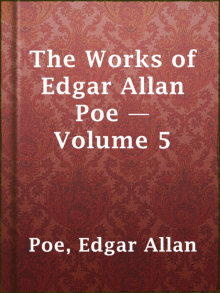 The Works of Edgar Allan Poe — Volume 5
The Works of Edgar Allan Poe — Volume 5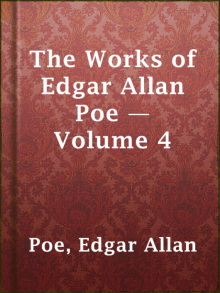 The Works of Edgar Allan Poe — Volume 4
The Works of Edgar Allan Poe — Volume 4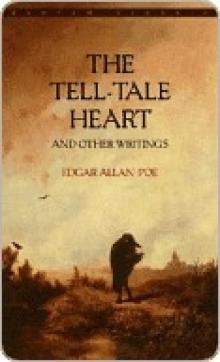 The Tell-Tale Heart
The Tell-Tale Heart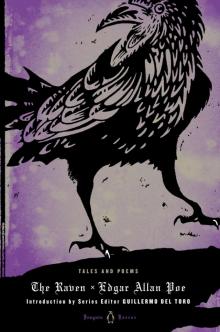 The Raven (Penguin)
The Raven (Penguin)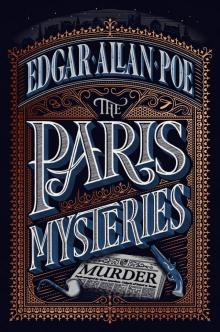 The Paris Mysteries
The Paris Mysteries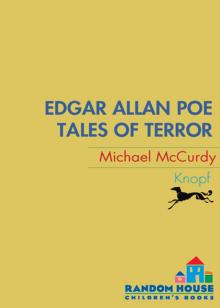 Tales of Terror from Edgar Allan Poe
Tales of Terror from Edgar Allan Poe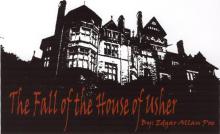 The Fall of the House of Usher
The Fall of the House of Usher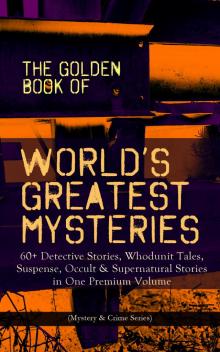 The Golden Book of World's Greatest Mysteries
The Golden Book of World's Greatest Mysteries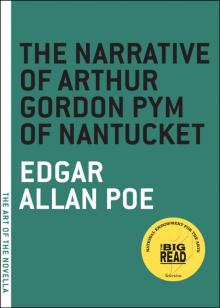 The Narrative of Arthur Gordon Pym of Nantucket
The Narrative of Arthur Gordon Pym of Nantucket Ligeia
Ligeia The Landscape Garden
The Landscape Garden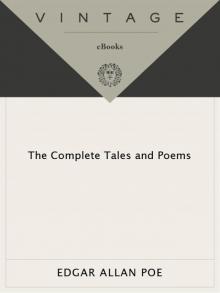 Complete Tales & Poems
Complete Tales & Poems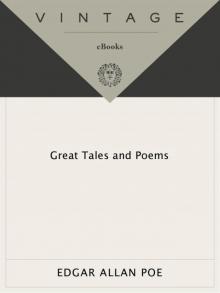 Great Tales and Poems of Edgar Allan Poe
Great Tales and Poems of Edgar Allan Poe The Colloquy of Monos and Una
The Colloquy of Monos and Una The Oblong Box
The Oblong Box Thou Art the Man
Thou Art the Man A DESCENT INTO THE MAELSTROM
A DESCENT INTO THE MAELSTROM THE MURDERS IN THE RUE MORGUE
THE MURDERS IN THE RUE MORGUE The Business Man
The Business Man The Mystery of Marie Rogêt
The Mystery of Marie Rogêt Metzengerstein
Metzengerstein The Man That Was Used Up
The Man That Was Used Up William Wilson
William Wilson The Philosophy of Composition
The Philosophy of Composition The Portable Edgar Allan Poe
The Portable Edgar Allan Poe Bon-Bon
Bon-Bon A Predicament
A Predicament The Premature Burial
The Premature Burial The Angel of the Odd
The Angel of the Odd The Man of the Crowd
The Man of the Crowd Never Bet the Devil Your Head
Never Bet the Devil Your Head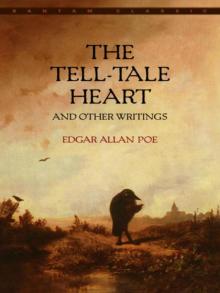 The Tell-Tale Heart and Other Writings
The Tell-Tale Heart and Other Writings The System of Doctor Tarr and Professor Fether
The System of Doctor Tarr and Professor Fether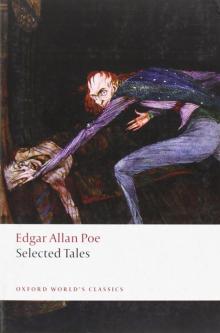 Selected Tales (Oxford World's Classics)
Selected Tales (Oxford World's Classics) Essential Tales and Poems of Edgar Allan Poe (Barnes & Noble Classics Series)
Essential Tales and Poems of Edgar Allan Poe (Barnes & Noble Classics Series) MS. Found in a Bottle
MS. Found in a Bottle Some Words with a Mummy
Some Words with a Mummy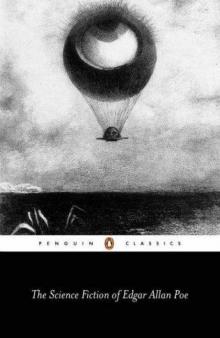 The Science Fiction of Edgar Allan Poe (Penguin Classics)
The Science Fiction of Edgar Allan Poe (Penguin Classics) King Pest
King Pest CRITICISM
CRITICISM How to Write a Blackwood Article
How to Write a Blackwood Article Mystification
Mystification Diddling Considered as One of the Exact Sciences
Diddling Considered as One of the Exact Sciences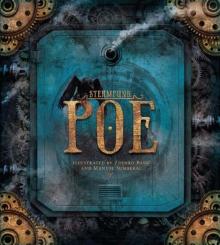 Steampunk Poe
Steampunk Poe The Literary Life of Thingum Bob, Esq.
The Literary Life of Thingum Bob, Esq.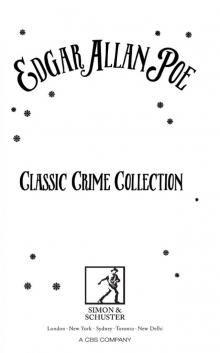 Classic Crime Collection
Classic Crime Collection Complete Stories and Poems of Edgar Allen Poe
Complete Stories and Poems of Edgar Allen Poe Berenice
Berenice The Black Cat
The Black Cat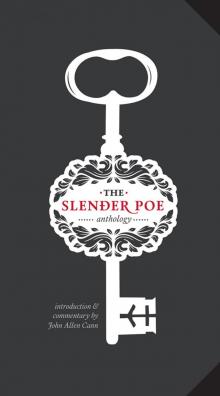 The Slender Poe Anthology
The Slender Poe Anthology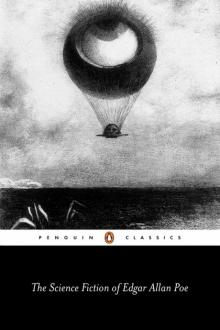 The Science Fiction of Edgar Allan Poe
The Science Fiction of Edgar Allan Poe The Assignation
The Assignation The Thousand-and-Second Tale of Scheherazade
The Thousand-and-Second Tale of Scheherazade The Raven and Other Short Stories
The Raven and Other Short Stories The Spectacles
The Spectacles Hop-Frog
Hop-Frog The Purloined Letter
The Purloined Letter Mellonta Tauta
Mellonta Tauta The Balloon-Hoax
The Balloon-Hoax Landor's Cottage
Landor's Cottage Mesmeric Revelation
Mesmeric Revelation The Pit and the Pendulum
The Pit and the Pendulum